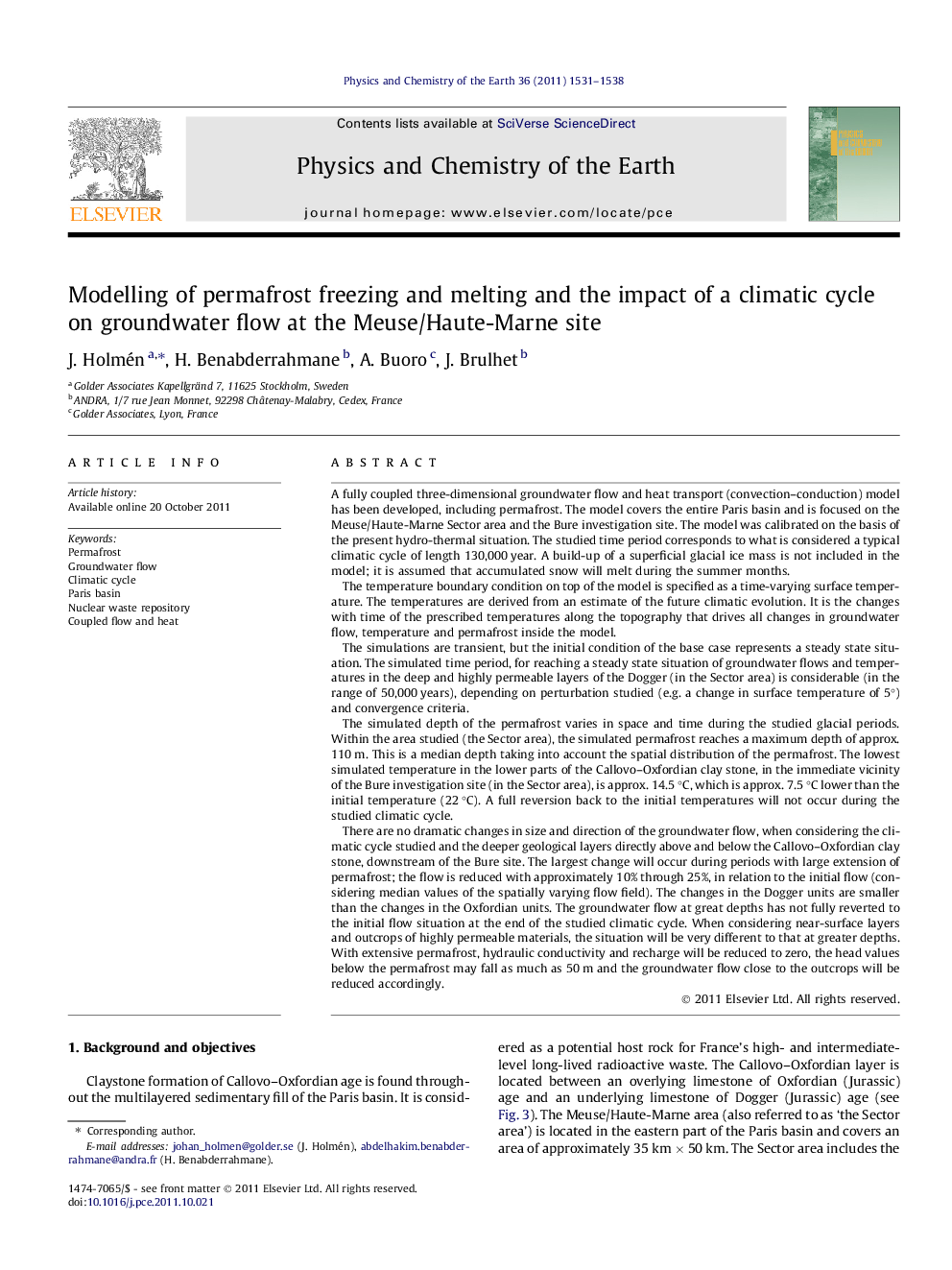| کد مقاله | کد نشریه | سال انتشار | مقاله انگلیسی | نسخه تمام متن |
|---|---|---|---|---|
| 4721229 | 1639372 | 2011 | 8 صفحه PDF | دانلود رایگان |

A fully coupled three-dimensional groundwater flow and heat transport (convection–conduction) model has been developed, including permafrost. The model covers the entire Paris basin and is focused on the Meuse/Haute-Marne Sector area and the Bure investigation site. The model was calibrated on the basis of the present hydro-thermal situation. The studied time period corresponds to what is considered a typical climatic cycle of length 130,000 year. A build-up of a superficial glacial ice mass is not included in the model; it is assumed that accumulated snow will melt during the summer months.The temperature boundary condition on top of the model is specified as a time-varying surface temperature. The temperatures are derived from an estimate of the future climatic evolution. It is the changes with time of the prescribed temperatures along the topography that drives all changes in groundwater flow, temperature and permafrost inside the model.The simulations are transient, but the initial condition of the base case represents a steady state situation. The simulated time period, for reaching a steady state situation of groundwater flows and temperatures in the deep and highly permeable layers of the Dogger (in the Sector area) is considerable (in the range of 50,000 years), depending on perturbation studied (e.g. a change in surface temperature of 5°) and convergence criteria.The simulated depth of the permafrost varies in space and time during the studied glacial periods. Within the area studied (the Sector area), the simulated permafrost reaches a maximum depth of approx. 110 m. This is a median depth taking into account the spatial distribution of the permafrost. The lowest simulated temperature in the lower parts of the Callovo–Oxfordian clay stone, in the immediate vicinity of the Bure investigation site (in the Sector area), is approx. 14.5 °C, which is approx. 7.5 °C lower than the initial temperature (22 °C). A full reversion back to the initial temperatures will not occur during the studied climatic cycle.There are no dramatic changes in size and direction of the groundwater flow, when considering the climatic cycle studied and the deeper geological layers directly above and below the Callovo–Oxfordian clay stone, downstream of the Bure site. The largest change will occur during periods with large extension of permafrost; the flow is reduced with approximately 10% through 25%, in relation to the initial flow (considering median values of the spatially varying flow field). The changes in the Dogger units are smaller than the changes in the Oxfordian units. The groundwater flow at great depths has not fully reverted to the initial flow situation at the end of the studied climatic cycle. When considering near-surface layers and outcrops of highly permeable materials, the situation will be very different to that at greater depths. With extensive permafrost, hydraulic conductivity and recharge will be reduced to zero, the head values below the permafrost may fall as much as 50 m and the groundwater flow close to the outcrops will be reduced accordingly.
► A coupled groundwater flow and heat transport model with permafrost has been developed.
► The model covers the Paris basin and the studied period is a climatic cycle.
► The simulated permafrost reaches a maximum depth of approx. 110 m, at the Bure site.
► Lowest simulated temperature at Bure and in the lower Callovo–Oxfordian is ca. 14.5 °C.
► Only small changes in size and direction of groundwater flow at great depth.
Journal: Physics and Chemistry of the Earth, Parts A/B/C - Volume 36, Issues 17–18, 2011, Pages 1531–1538